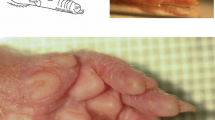Summary
-
1.
Response characteristics of unmyelinated cutaneous fibres with receptors sensitive to heating of the skin were determined by controlled radiant heat stimulation applied to the foot sole of anaesthetized cats. To evaluate response characteristics without repetitive stimulation the skin surface temperature was raised stepwise (“staircase”) up to noxious levels in each trial.
-
2.
A monotonically increasing discharge rate on increasing temperature (up to the highest temperatures tested, 52–55°C) was shown by 29 out of 47 heat sensitive C-fibres, i.e. by about 60% of the receptors, whereas 13 fibres, about 30%, had discharges which were found to be presumably unsuitable for discriminating temperature levels above 50°C. The threshold temperatures of both fibre groups were found to be usually near 40°C. Thus our results indicate different temperature ranges among heat receptors with potential nociceptive functions.
-
3.
Five fibres of our sample, i.e. about 10%, could be identified as “warm fibres”. They had tresholds near 30°C and had their discharge maxima at 44°C. In contrast to the “heat-fibres” mentioned above they were inactivated during tonic noxious heat stimulation and in the time following. Though warm fibres respond with a burst of high frequency when the skin temperature is raised suddenly from normal to noxious levels and though they start to discharge again irregularly at noxious temperatures (e.g. 50°C) after a silent period, when stimulated tonically, warm fibres seem to transmit little quantitative information about noxious temperature levels. Therefore they can presumably be discarded as “nociceptors”.
Similar content being viewed by others
References
Beck, P. W., Handwerker, H. O.: Bradykinin and serotonin effects on various types of cutaneous nerve fibres. Pflügers Arch.347, 209–222 (1974)
Beck, P. W., Handwerker, H. O., Zimmermann, M.: Nervous outflow from the cat's foot during noxious radiant heat stimulation. Brain Res.67, 373–386 (1974)
Bessou, P., Perl, E. R.: Response of cutaneous sensory units with unmyelinated fibres to noxious stimuli. J. Neurophysiol.32, 1025–1043 (1969)
Burgess, P. R., Perl, E. R.: Cutaneous mechanoreceptors and nociceptors. In: Handbook of sensory physiology, Vol. II (A. Iggo, ed.). Berlin-Heidelberg-New York: Springer 1973
Finger, S., Norrsell, U.: Temperature sensitivity of the paw of the cat: a behavioral study. J. Physiol. (Lond.)239, 631–646 (1974)
Handwerker, H. O., Iggo, A., Zimmermann, M.: Segmental and supraspinal actions on dorsal horn neurons responding to noxious and non-noxious skin stimuli. Pain1, 147–165 (1975)
Hardy, J. D., Wolff, H. G., Goodell, H.: Pain sensations and reactions. Baltimore: Williams and Wilkins 1952
van Hees, J.: Afferent C fiber activity in the human cutaneous nerve in relation to pain sensation. First World Congress on Pain, Florence 1975.
Hensel, H.: Thermoreceptors. Ann. Rev. Physiol.36, 233–249 (1974)
Hensel, H., Iggo, A., Witt, I.: A quantititative study of sensitive cutaneous thermoreceptors with C afferent fibres. J. Physiol. (Lond.)153, 113–126 (1960)
Hensel, H., Kenshalo, D. R.: Warm receptors in the nasal region of cats. J. Physiol. (Lond.)204, 99–112 (1969)
Iggo, A.: The electrophysiological identification of single nerve fibres, with particular reference to the slowest-conducting vagal fibres in the cat. J. Physiol. (Lond.)142, 110–126 (1958)
Iggo, A.: Cutaneous heat and cold receptors with slowly conducting (C) afferent fibres. Quart. J. exp. Physiol.44, 362–370 (1959)
Iggo, A., Ogawa, H.: Primate cutaneous thermal nociceptors. J. Physiol. (Lond.)216, 77–78P (1971)
Iriuchijima, J., Zotterman, Y.: The specifity of afferent cutaneous C-fibres in mammals. Acta physiol. scand.49, 267–278 (1960)
Kenshalo, D. R., Duncan, P. G., Weymark, C.: Thresholds for thermal stimulation of the inner thigh, footpad and face of cats. J. comp. physiol. Psychol.63, 133–138 (1967)
Perl, E. R., Kumazawa, T., Lynn, B., Kenins, P.: Sensitization of high threshold receptors with unmyelinated (C) afferent fibres. In: Progress in brain research, Vol. 43 (A. Iggo and O. B. Ilyinsky, eds.) Amsterdam-Oxford-New York: Elsevier Scientific Publ. Comp. 1976
Sumino, R., Dubner, R., Starkman, S.: Responses of small myelinated ‘warm’ fibers to noxious heat stimuli applied to the monkey's face. Brain Res.62, 260–263 (1973)
Zimmermann, M., Handwerker, H. O.: Total afferent inflow and dorsal horn activity upon radiant heat stimulation to the cat's footpad. In: Advances in neurology (J. J. Bonica, ed.). New York: Raven Press 1974
Zotterman, Y.: Touch, pain and tickling: an electrophysiological investigation on cutaneous sensory nerves. J. Physiol. (Lond.)95, 1–28 (1939)
Author information
Authors and Affiliations
Rights and permissions
About this article
Cite this article
Handwerker, H.O., Neher, KD. Characteristics of C-fibre receptors in the cat's foot responding to stepwise increase of skin temperature to noxious levels. Pflugers Arch. 365, 221–229 (1976). https://doi.org/10.1007/BF01067022
Received:
Issue Date:
DOI: https://doi.org/10.1007/BF01067022




